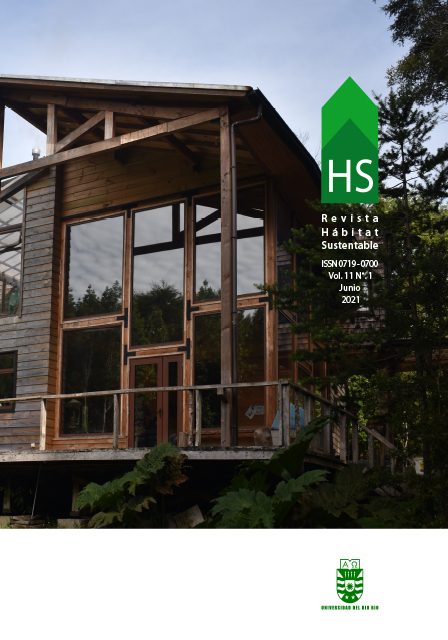Minga: sustainable and replicable urban renovation model, the Buenaventura case
DOI:
https://doi.org/10.22320/07190700.2021.11.01.05Keywords:
sustainable urbanism, climate change, social housingAbstract
This article presents the results obtained in research made during a sustainable urban renewal design in the city of Buenaventura, Valle del Cauca, Colombia, as part of MINGA team's proposal for SDLAC 2019 (Solar Decathlon Latin America and Caribbean). This project was developed by a group of students and professors, as part of the undergraduate programs of architecture and civil engineering of the partner universities in the MINGA team. A project-based teaching-learning methodology was used, integrating the curricula in interdisciplinary project workshop-type courses. The main goal was to demonstrate the viability of a resilient urban planning project, conceived for the future climate in a coastal city in the hot-humid tropics. The results showed that a climate-resilient urbanism can be created, which guarantees the permanence of the original inhabitants of the coastal areas, mitigating flooding risks, and preserving the cultural roots of the inhabitants, even under sea-rise scenarios.
Downloads
References
ALCALDÍA DE BUENAVENTURA. (2001) Acuerdo 03 de 2001, Plan de Ordenamiento Territorial POT “Convivencia Pacífica desde la Diversidad”, Buenaventura 2001
BARRAGÁN, J. M., & DE ANDRÉS, M. (2016). Expansión urbana en las áreas litorales de América Latina y Caribe. Revista de Geografía Norte Grande, (64), 129-149.
BÉNÉ, C., MEHTA, L., MCGRANAHAN, G., CANNON, T., GUPTE, J., TANNER, T., 2018. Resilience as a policy narrative: potentials and limits in the context of urban planning. Clim. Dev. 10, 116–133. https://doi.org/10.1080/17565529.2017.1301868
COCUÑAME RICARDO, D. , SALCEDO HURTADO, E. (2017). Evaluación del riesgo de inundación ante tsunami local en la isla de Cascajal, Pacífico Colombiano. Revista de geografía Norte Grande, (68), 185-219.
DANE (2005) Proyecciones de población municipales por área. In: Proyección municipios 2005 - 2020. DANE (Departamento Administrativo Nacional de Estadística)
DANE (2005) Boletín perfil general Buenaventura, Valle del Cauca, Colombia. Censo general 2005.
HERNÁNDEZ-GUERRERO, J., VIEYRA-MEDRANO, A., MENDOZA, M.E., 2012. Adaptation strategies in communities under precarious housing: Flooding risks in the peri-urban sector of the city of Morelia, Michoacán, México. Appl. Geogr. 34, 669–679. https://doi.org/10.1016/j.apgeog.2012.04.010
DANE (2018) Necesidades Básicas Insatisfechas Comparación CG 2005 y CNPV 2018. In: Resultados Censo Nacional de Población y Vivienda 2018. Bogotá D.C.
FEDESARROLLO, CENTRO DE RECURSOS PARA ANÁLISIS DE Conflictos –CERAC (2013). Hacia un desarrollo integral de la ciudad de Buenaventura y su área de Influencia. Bogotá D.C.
HERNÁNDEZ ARAQUE, M.J., 2016. Urbanismo participativo. Construcción social del espacio urbano. Rev. Arquit. 18, 6–17. https://doi.org/10.14718/revarq.2016.18.1.2
HERNANTES, J., MARAÑA, P., GIMENEZ, R., SARRIEGI, J.M., LABAKA, L., 2019. Towards resilient cities: A maturity model for operationalizing resilience. Cities 84, 96–103. https://doi.org/10.1016/j.cities.2018.07.010
HUMAN RIGHTS WATCH (2014). THE CRISIS IN BUENAVENTURA: Disappearances, Dismemberment, and Displacement in Colombia’s Main Pacific Port.
KAVITI MUSANGO, J., CURRIE, P., SMIT, S., KOVACIC, Z., 2020. Urban metabolism of the informal city: Probing and measuring the ‘unmeasurable’ to monitor Sustainable Development Goal 11 indicators. Ecol. Indic. 119, 106746. https://doi.org/10.1016/j.ecolind.2020.106746
LONG, J., RICE, J.L., 2019. From sustainable urbanism to climate urbanism. Urban Stud. 56, 992–1008. https://doi.org/10.1177/0042098018770846
MEEROW, S., NEWELL, J.P., STULTS, M., 2016. Defining urban resilience: A review. Landsc. Urban Plan. 147, 38–49. https://doi.org/10.1016/j.landurbplan.2015.11.011
NEUMANN, B., VAFEIDIS, A.T., ZIMMERMANN, J., NICHOLLS, R.J., 2015. Future coastal population growth and exposure to sea-level rise and coastal flooding - A global assessment. PLoS One 10. https://doi.org/10.1371/journal.pone.0118571
Nicholls, R.J., Hanson, S.E., Lowe, J.A., Warrick, R.A., Lu, X., Long, A.J., 2014. Sea-level scenarios for evaluating coastal impacts. Wiley Interdiscip. Rev. Clim. Chang. 5, 129–150. https://doi.org/10.1002/wcc.253
RAFFERTY J. (2009) Köppen climate classification. Wet equatorial climate. In: Tropical monsoon and trade-wind littoral climate. Encyclopedia Britannica. Disponible vía: https://www.britannica.com/science/Koppen-climate-classification
SDLAC (2019) Rules Adjusted Version. (09 de septiembre de 2019). In: Solar Decathlon Latin America & Caribbean 2019. Recuperado el 14 de 02 de 2020. Disponible vía: https://solardecathlonlac.com
URRIZA, G., & GARRIZ, E. (2014). ¿ Expansión urbana o desarrollo compacto? Estado de situación en una ciudad intermedia: Bahía Blanca, Argentina. Revista Universitaria de Geografía, 23(2), 97-123.
VERGEL TOVAR, E., 2010. Asentamientos precarios Una aproximación para su mejoramiento integral y prevención. Dearq 64–81. https://doi.org/10.18389/dearq6.2010.08
WARDEKKER, J.A., DE JONG, A., KNOOP, J.M., VAN DER SLUIJS, J.P., 2010. Operationalising a resilience approach to adapting an urban delta to uncertain climate changes. Technol. Forecast. Soc. Change 77, 987–998. https://doi.org/10.1016/j.techfore.2009.11.005
WHO (2016) Urban green spaces and health. Copenhagen: WHO (World Health Organization) Regional Office for Europe.
YIGITCANLAR T, KAMRUZZAMAN MD., FOTH M, SABATINI-MARQUES J, DA COSTA E, IOPPOLO G. (2019) Can cities become smart without being sustainable? A systematic review of the literature. In: Elsevier Ltd. Sustainable Cities and Society, Vol. 45., Amsterdam, p. 348-365.
Downloads
Published
How to Cite
Issue
Section
License
Copyright (c) 2021 Valeria Villamil-Cárdenas, Ivan Osuna-Motta

This work is licensed under a Creative Commons Attribution-ShareAlike 4.0 International License.
The content of articles which are published in each edition of Habitat Sustentable, is the exclusive responsibility of the author(s) and does not necessarily represent the thinking or compromise the opinion of University of the Bio-Bio.
The author(s) conserve their copyright and guarantee to the journal, the right of first publication of their work. This will simultaneously be subject to the Creative Commons Recognition License CC BY-SA, which allows others to share-copy, transform or create new materials from this work for non-commercial purposes, as long as they recognize authorship and the first publication in this journal, and its new creations are under a license with the same terms.











 Scientific Information Program/Concurso Fondos de Publicación de Revistas Científicas 2018/ Proyecto Mejoramiento de Visibilidad de Revistas UBB (Código:FP180007).
Scientific Information Program/Concurso Fondos de Publicación de Revistas Científicas 2018/ Proyecto Mejoramiento de Visibilidad de Revistas UBB (Código:FP180007).





